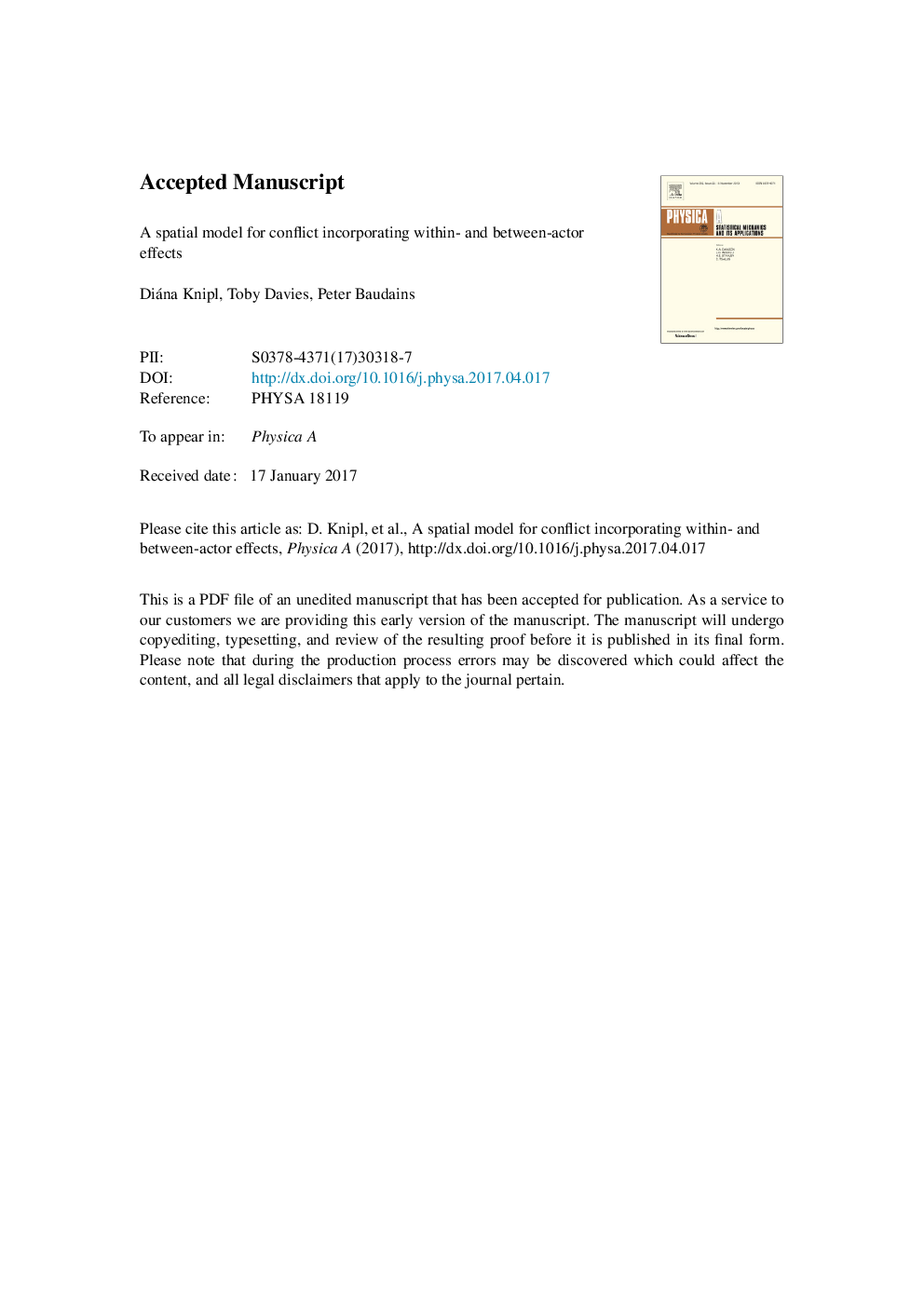| کد مقاله | کد نشریه | سال انتشار | مقاله انگلیسی | نسخه تمام متن |
|---|---|---|---|---|
| 5102756 | 1480090 | 2017 | 36 صفحه PDF | دانلود رایگان |
عنوان انگلیسی مقاله ISI
A spatial model for conflict incorporating within- and between-actor effects
ترجمه فارسی عنوان
یک مدل فضایی برای درگیری با تأثیرات درون و بین بازیگر
دانلود مقاله + سفارش ترجمه
دانلود مقاله ISI انگلیسی
رایگان برای ایرانیان
کلمات کلیدی
تعارض، انتشار واکنش اقدام درونی طرفدار، تجزیه و تحلیل ثبات،
ترجمه چکیده
استفاده از مدل های اکولوژیکی به سناریوهای منازعات انسانی سبب تعدیل تعدادی از مدل هایی شده است که روابط متقابل بین مخالفان را توصیف می کند. کار اخیر نشان می دهد که تقسیم فضایی چنین مدل ها نه تنها به خوبی انگیزه است، بلکه موجب رفتار پویا جالب نیز می شود، به خصوص در رابطه با توزیع فضایی منابع. با این حال یکی از ویژگی های که عمدتا از مدل های قبلی غایب است، توانایی یک مخالف برای هماهنگ کردن فعالیت در مکان های مختلف آن است. بیشتر بلافاصله این به مفهوم "حمایت" مربوط می شود - انتقال مجدد منابع از یک سایت به دیگری با توجه به نیاز - که نقش مهمی در منازعات واقعی بازی می کند. در این مقاله، ما یک فرایند فضایی و بدون تفکیک مدل کلاسیک ریچاردسون از تشدید درگیری را با اضافه کردن یک اصطلاح تعاملی متقابل برای پویایی درون هر دشمن در هر مکان به کلی تعمیم می دهیم. ما مدل را به صورت تحلیلی بررسی می کنیم، که شرایط را برای ثبات حالت متعادل متعادل فراهم می کند. سپس ما تعدادی از شبیه سازی های عددی را انجام می دهیم که با سناریوهای تقلید در دنیای واقعی در ارتباط هستند. سپس برنامه های کاربردی بالقوه مدل و پیامدهای آن برای سیاست، مورد بحث قرار می گیرند.
موضوعات مرتبط
مهندسی و علوم پایه
ریاضیات
فیزیک ریاضی
چکیده انگلیسی
The application of ecological models to human conflict scenarios has given rise to a number of models which describe antagonistic relationships between adversaries. Recent work demonstrates that the spatial disaggregation of such models is not only well-motivated but also gives rise to interesting dynamic behaviour, particularly with respect to the spatial distribution of resources. One feature which is largely absent from previous models, however, is the ability of an adversary to coordinate activity across its various locations. Most immediately, this corresponds to the notion of 'support' - the reallocation of resources from one site to another according to need - which plays an important role in real-world conflict. In this paper, we generalise a spatially-disaggregated form of the classic Richardson model of conflict escalation by adding a cross-location interaction term for the within-adversary dynamics at each location. We explore the model analytically, giving conditions for the stability of the balanced equilibrium state. We then also carry out a number of numerical simulations which correspond to stylised real-world conflict scenarios. Potential further applications of the model, and its implications for policy, are then discussed.
ناشر
Database: Elsevier - ScienceDirect (ساینس دایرکت)
Journal: Physica A: Statistical Mechanics and its Applications - Volume 483, 1 October 2017, Pages 517-533
Journal: Physica A: Statistical Mechanics and its Applications - Volume 483, 1 October 2017, Pages 517-533
نویسندگان
Diána Knipl, Toby Davies, Peter Baudains,
